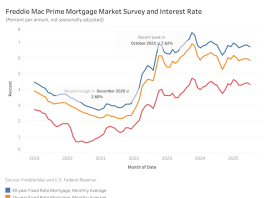
The national market is cooling overall, but the pace and severity of the slowdown varies widely across regions, according to the latestĢż. The South and West are shifting decisively in favor of buyers, with rising inventory, deeper price cuts, and longer time on market. In contrast, conditions in the Northeast and Midwest remain much tighter. Nationally, active listings rose for the 21st straight month, homes took 7 days longer to sell than last year, and 33 of the 50 largest metros posted year-over-year price declinesāincludingĢżAustinĢż(-4.9%),ĢżMiamiĢż(-4.7%), andĢżChicagoĢż(-4.4%) and more than one in five sellers cut their asking price.
āThe housing market has cooled modestly in 2025, prompting our lowered outlook for home sales and price growth. But the extent and persistence of rebalancing really varies across the country, and, regionally, homebuyers and sellers are likely to experience a very different market,ā saidĢżDanielle Hale, Chief Economist at Realtor.comĀ®. āIn the South and West, weāre seeing clear signs of a shift toward buyer-friendly conditionsāmore price cuts, rising delistings, and homes sitting longer on the marketāwhich has led to sometimes sizable price adjustments since 2022. Meanwhile, the Midwest and Northeast remain relatively tight, with less inventory relief and stronger pricing power for sellers. This widening divide underscores how local market dynamics are driving very different experiences for buyers and sellers.ā
Southern and Western Markets Lead Price Declines
While some metros continue to hold onto post-pandemic price gains, others, most notably in the South and West have started to reverse course. In July, 33 of the 50 largest metros posted year-over-year price declines.ĢżMiami,ĢżAustin,ĢżChicago, andĢżLos AngelesĢżled the way in terms of largest year-over-year median list price declines, however, where prices are declining most right now is not necessarily where they have declined the most since the peak of the market in 2022.
āWeāre seeing a reset take hold in markets across the country such asĢżNashville. List prices are softening, homes are spending more time on the market, and buyers are finding more room to negotiate,ā saidĢżGary Ashton, founder of The Ashton Real Estate Group of RE/MAX Advantage. āAfter years of intense competition, itās starting to feel more balanced ā especially in the South and West. Itās not a buyerās market yet, but weāre headed in that direction.ā
MiamiāsĢżmedian list price is now 17.8% lower than itsĢżJuly 2022Ģżpeak. Meanwhile,ĢżLos AngelesĢżsaw prices 18% higher than inĢżJuly 2022Ģżā a stark contrast fromĢżAustin, where prices declined 4.9% since last year and prices are now 14.8% below 2022 levels.
Only 19 of the 50 largest U.S. metros currently have prices belowĢżJuly 2022, and all are located in the South and West. Furthermore, each of these 19 has seen prices decline further in the last yearāexcept forĢżSeattle, which has eked out 0.8% year-over-year growth.
Price Cuts Still Elevated Especially in the South and West, but Dip Modestly in July
Price cuts continue to be a key feature of this summerās market, even if median list prices have shown little movement overall. In July 20.6% of home listings had price reductionsāup a modest 1.1 percentage points from last year, but down from 20.7% last month. This marks the first time in 6 months that price cuts have declined nationally.
Regionally, price cuts were far more common in the South and West (23%) than in the Northeast (12.7%). Metros with the most listings with price cuts, often linked to slower demand, included:ĢżDenverĢż(32.9% of listings),ĢżPortlandĢż(31.3%), andĢżAustinĢż(31.2%).
Delistings Surge as Sellers Retreat
Sellers who couldnāt find buyers at their desired price continued to pull listings from the market. Delistings in June (reported with a one-month lag) rose 48% year-over-year and 38% year-to-date. The delisting-to-new listing ratio climbed to 0.21 in June, up from 0.13 in Mayāmeaning that for every 100 new listings, 21 were removed without a sale. The metros with the highest delisting ratios in June wereĢżMiamiĢż(59 per 100 new listings),ĢżPhoenixĢż(37), andĢżRiverside, Calif.Ģż(30).
Inventory Growth Slows But Persists
The number of homes actively for sale in July rose 25.1% compared to July of last year, marking the 21st consecutive month of year-over-year gains and there are now over 1.1 million homes for sale nationwide, the third consecutive month with over 1 million active listings. However, the pace of growth is slowingādown from 28.9% year-over-year in June and 31.5% in May. Inventory remains 13.4% below typical 2017ā2019 levels, indicating that while buyers have more choices, supply is still constrained by historical standards.
Inventory increased in all four major U.S. regions in July, though the pace varied: West: +32.5%, South: +25.4%, Midwest: +18.1%, Northeast: +15.5%.
Ģż



